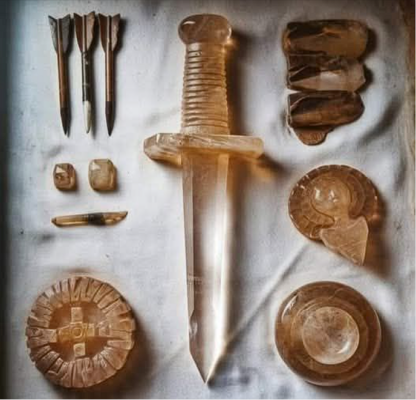The Discovery of a 5,000-Year-Old Crystal Dagger
Unearthing a Prehistoric Treasure
In the heart of southern Spain, within the Montelirio Tholos, archaeologists made an extraordinary discovery—a dagger carved entirely from rock crystal, dating back 5,000 years. This rare find, measuring 8.5 inches (22 cm) in length, was unearthed alongside a collection of other crystal artifacts, including 10 arrowheads, 4 blades, and a core used for crafting additional weapons. These relics offer a fascinating glimpse into the sophisticated craftsmanship and spiritual beliefs of Neolithic societies.
The Montelirio Tholos: A Megalithic Burial Site
The Montelirio Tholos is an elaborate megalithic tomb constructed with massive slabs of slate. It served as a communal burial chamber for high-ranking individuals of the time. Within its chambers, archaeologists discovered remains of at least 20 individuals, along with intricate grave goods that highlight the site’s significance. The presence of rock crystal artifacts suggests that these objects held profound symbolic meaning, possibly linked to power, spirituality, and the afterlife.
The Significance of Rock Crystal in Neolithic Culture
A Material of Mystery and Prestige
Unlike flint or other commonly used materials, rock crystal was extremely rare and difficult to work with. The effort required to craft such precise weaponry from this luminous stone indicates its exceptional value. Scholars believe that crystal was reserved for the elite, symbolizing purity, mysticism, and a connection to supernatural forces.
Spiritual and Funerary Symbolism
The Neolithic people may have viewed rock crystal as a conduit between the physical and spiritual realms. The dagger and other crystal artifacts found in the Montelirio Tholos could have been part of a ritualistic burial tradition, ensuring safe passage to the afterlife. These artifacts may have represented clarity, foresight, or divine protection, granting their owners a privileged position both in life and death.

The Craftsmanship Behind the Crystal Dagger
Advanced Stoneworking Techniques
Creating a weapon from rock crystal required exceptional skill and craftsmanship. Unlike metal, which can be melted and shaped, crystal must be painstakingly chipped away to form the desired shape. The precision of the dagger’s blade suggests that Neolithic artisans had mastered sophisticated techniques, possibly using pressure flaking and polishing methods to achieve a razor-sharp edge.
A Testament to Neolithic Innovation
The discovery of the crystal dagger not only showcases artistic excellence but also raises questions about the technological advancements of early European civilizations. How did Neolithic craftsmen acquire such refined techniques? Did they trade for high-quality crystal from distant regions? These questions continue to intrigue researchers as they seek to unravel the mysteries of prehistoric craftsmanship.
Theories Surrounding The Shard of Eternity
A Weapon of a Warrior or a Sacred Relic?
Some historians speculate that the crystal dagger, known as The Shard of Eternity, belonged to a powerful chieftain or spiritual leader. Unlike ordinary weapons, this dagger may have served ceremonial purposes rather than practical combat. Rock crystal, believed to hold mystical properties, could have been used in rituals to communicate with deities or ancestors.
A Gateway Between Worlds
The dagger’s ethereal glow, even after millennia buried beneath the earth, reinforces its otherworldly allure. Many ancient cultures associated rock crystal with vision and prophecy. It is possible that this weapon was not meant for battle, but rather as a spiritual bridge—guiding the deceased into the next life. The carefully placed arrowheads and blades found beside it suggest that the chieftain or noble figure was sent on their final journey fully armed, prepared for whatever lay beyond.
The Legacy of the Crystal Dagger
A Testament to an Advanced Civilization
The Montelirio Tholos discovery reshapes our understanding of Neolithic societies in Iberia. Far from being primitive, these cultures possessed intricate burial customs, artistic mastery, and a deep reverence for the metaphysical world. The craftsmanship of the crystal dagger serves as undeniable proof that early European civilizations were more sophisticated than previously believed.
Inspiring Future Research
This remarkable find continues to fuel archaeological research, urging scholars to explore the broader implications of rock crystal usage in prehistory. Were similar crystal weapons crafted elsewhere in Europe? What other spiritual or ceremonial functions did these objects serve? As excavations and analyses progress, the answers to these questions may reveal even deeper insights into humanity’s ancient past.
Conclusion
The 5,000-year-old rock crystal dagger from the Montelirio Tholos stands as one of the most enigmatic and breathtaking discoveries in archaeology. Whether viewed as a symbol of power, a sacred relic, or a tool for passage into the afterlife, this artifact provides an extraordinary link to a civilization that sought meaning beyond the material world. As researchers continue to study its origins, the dagger remains a shimmering testament to the mysteries of the Neolithic age.

CÁC TIN KHÁC
Mary Walton: The Forgotten Inventor Who Helped Clean Up America’s Cities
Tomb of Queen Nefertari in the Valley of the Queens, Egypt
Discover the Hypostyle Hall of the Temple of Hathor at Dendera
Venus de Losange: Unveiling the Mystery of a 20,000-Year-Old Paleolithic Icon